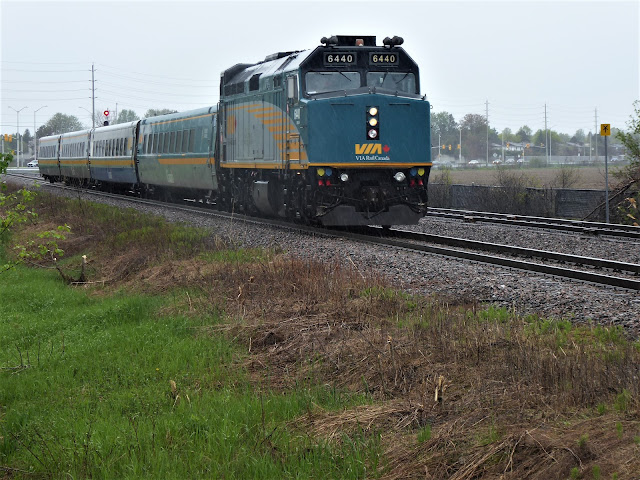The other day, I had some time to kill so I made my way to Fallowfield Station just for the heck of it. I was hoping I might be able to see something different. Sadly, I saw one of the more typical consists that were standard fare in the Ottawa-Montreal-Toronto triangle before Via embarked on its wrap program. I saw an F40PH-2 pulling four LRC coaches with no wraps. Wait, is this lack of variety now exceptional in its atypical blandness, perhaps? I don't remember the last time I have caught a Via Rail consist with no wraps. Such is the state of railfanning in Ottawa these days.
When I arrived at the station, it was raining, which is nothing new in Ottawa these days. I took a few cursory photos and then went about my day. It wasn't until I got home and took a good look at some of the images that I noticed how much the rain showed up in the photo. I'm sure a better photographer could have done more to accentuate the rain. I tried to do some touching up to make the rain stand out, but I could only do so much.
This series of shots made me wonder why I have so few images of trains in the rain. I have an endless number of sunny summer day shots and a growing number of winter snow shots, but not a lot of rain shots.
Well, not many inclement summer shots, anyway. I have a few shots scattered shots of rain, but not much worth sharing here. I did manage this shot near Highway 416 as a summer storm came charging north into the city behind this Toronto-bound train. Not long after this shot, our city was slammed by a pretty intense downpour. Timing is everything.
Here's another decent shot that technically qualifies as a rain shot, although it's more of a winter shot, since snow is still on the ground. This one was taken at the Twin Elm crossing. The rain is more of a mist, so this one is borderline for our purposes.
I have a few shots post-rainfall, which I really like, such as this one taken near Fallowfield Station. Hey have you noticed every shot in this post is of a certain vintage? The P42s are all in Via blue and yellow? Will we one day look back at shots from the middle part of this decade as vintage shots? I wonder.
I was also thinking that, for a future post, I might actually tally how many Via rail locomotives I have captured. Since I have shot more Via corridor consists than any other trains since beginning this blog, I figured it might be worthwhile to see how far I have gotten in capturing the entire Via roster. It might be fun to make a game of it.
This collection of photographers also had me thinking how few autumn shots I have in my archives. Time to branch out, I guess.
Random note:
A small piece of information for local railfans. I was driving on Conroy Road recently where the road crosses over the tracks leading to CN's Walkley Yard. I always take a quick look to see if anything is happening in the yard when I am on Conroy. I noticed an Ottawa Police SUV on the access road next to the tracks, which only reaffirmed to me that I made the right decision some time ago to not use this road for photos. At one point, I thought it was a grey area, since the road is an extension of Albion Road and it does have a business located on the access road. However, as most responsible railfans will tell you, it's not worth the risk. Railways take security very seriously and they do not want anyone trespassing on private property.












